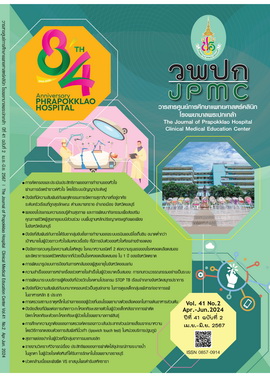ปัจจัยการควบคุมโรคความดันโลหิตสูง โรคเบาหวานชนิดที่ 2 ต่อความรุนแรงของโรคหลอดเลือดสมอง และอัตราการรอดชีวิตหลังจากที่ป่วยเป็นโรคหลอดเลือดสมอง ใน 1 ปี ของจังหวัดตราด
Main Article Content
บทคัดย่อ
ที่มาของปัญหา: สถานการณ์กลุ่มโรคไม่ติดต่อเรื้อรังเป็นปัญหาสุขภาพอันดับหนึ่งของโลก โดยสถานการณ์ในประเทศไทยตั้งแต่ปี พ.ศ. 2560-2565 พบผู้ป่วยโรคหลอดเลือดสมอง และอัตราตายที่สูงขึ้น สำหรับสถานการณ์ในจังหวัดตราด พบสถานการณ์อัตราการป่วยมีแนวโน้มคงที่ ส่วนอัตราตายต่อประชากรแสนคนจากโรคหลอดเลือดสมอง มีแนวโน้มสูงขึ้นอย่างต่อเนื่อง จึงได้ศึกษาปัจจัยการควบคุมโรคเรื้อรังทั้งโรคความดันโลหิตสูง โรคเบาหวานชนิดที่ 2 ซึ่งเป็นปัจจัยเสี่ยงที่สำคัญต่อการเกิดโรคหลอดเลือดสมอง มีผลต่อความรุนแรงของโรค และอัตราการรอดชีวิตหลังจากป่วยเป็นโรคหลอดเลือดสมอง เพื่อใช้เป็นข้อมูลในการดูแลผู้ป่วยต่อไป
วัตถุประสงค์: เพื่อศึกษาปัจจัยการควบคุมโรคความดันโลหิตสูง โรคเบาหวานชนิดที่ 2 ที่มีผลต่อความรุนแรงของโรคหลอดเลือดสมอง และอัตราการรอดชีวิตหลังจากที่ป่วยเป็นโรคหลอดเลือดสมองใน 1 ปี ของจังหวัดตราด
วิธีการศึกษา: เป็นงานวิจัยเชิงวิเคราะห์แบบย้อนหลังโดยใช้แบบบันทึกข้อมูลเก็บข้อมูลผู้ป่วยโรคความดันโลหิตสูง และโรคเบาหวานชนิดที่ 2 ที่เข้าสู่ระบบการรักษาโรคหลอดเลือดสมองของโรงพยาบาลตราด ปีงบประมาณ 2565 จำนวน 291 ราย วิเคราะห์ข้อมูลโดยใช้สถิติการทดสอบไคสแควร์ทดสอบความสัมพันธ์ของการควบคุมโรคเรื้อรังกับระดับความรุนแรงของโรคหลอดเลือดสมอง และ Kaplan-Meier Curve ทดสอบสมมติฐานในการเปรียบเทียบอัตรารอดชีพโดยใช้สถิติ Log-rank test
ผลการศึกษา: การควบคุมโรคความดันโลหิตสูงที่ดี มีผลทำให้ลดระดับความรุนแรงของการเกิดโรคหลอดเลือดสมอง แต่ไม่มีผลต่ออัตราการรอดชีวิตของผู้ป่วยในระยะเวลา 1 ปี ส่วนการควบคุมโรคเบาหวานชนิดที่ 2 และโรคความดันโลหิตสูงร่วมกับโรคเบาหวานชนิดที่ 2 ไม่มีผลต่อระดับความรุนแรงของการเกิดโรคหลอดเลือดสมอง และอัตราการรอดชีวิตของผู้ป่วยในระยะเวลา 1 ปี
สรุป: ผู้ป่วยโรคความดันโลหิตสูงที่สามารถความคุมระดับความดันให้ได้ดี จะพบความรุนแรงของโรคหลอดเลือดสมองในตอนแรกรับน้อยกว่ากลุ่มที่ควบคุมโรคไม่ดี
ClinicalTrials.gov Identifier, NCT06288269
Article Details

This work is licensed under a Creative Commons Attribution-NonCommercial-NoDerivatives 4.0 International License.
References
Ministry of Public Health. Report on the situation of NCDs, diabetes, high blood pressure and related risk factors 2019. Nonthaburi: Ministry of Public Health; 2020.
World Stroke Organization. WSO global stroke fact sheet 2022 [Internet]. 2022. [cited 2023 Sep 10]. Available from: https://www.world-stroke.org/news-and-blog/news/wso-global-stroke-fact-sheet-2022
Health Data Center. Rate of new patients from stroke [Internet]. 2023 [cited 2023 Sep 10] Available from: https://hdcservice.moph.go.th/hdc/reports/report.php?cat_id=39fd60c25235db479930db85a0e97dd3&id=b184366d9fa112292f8374184b21e1a8
Kogan E, Twyman K, Heap J, Milentijevic D, Lin JH, Alberts M. Assessing stroke severity using electronic health record data: a machine learning approach. BMC Med Inform DecisMak [Internet]. 2020. [cited 2023 Sep 10];20(1):8. Available from: https://www.ncbi.nlm.nih.gov/pmc/articles/PMC6950922/pdf/12911_2019_Article_1010.pdf
Tziomalos K, Spanou M, Bouziana SD, Papadopoulou M, Giampatzis V, Kostaki S, et al. Type 2 diabetes is associated with a worse functional outcome of ischemic stroke. World J Diabetes 2014;5:939-44.
Alawneh KZ, Qawasmeh MA, Raffee LA, Al-Mistarehi AH. Ischemic stroke demographics, clinical features and scales and their correlations: an exploratory study from Jordan. Future Sci OA [Internet]. 2022 [cited 2023 Sep 10];8(7):FSO809. Available from: https://www.ncbi.nlm.nih.gov/pmc/articles/PMC9540235/pdf/fsoa-08-809.pdf
Zhang X, Liu Y, Zhang F, Li J, Tong N. Legacy effect of intensive blood glucose control on cardiovascular outcomes in patients with type 2 diabetes and very high risk or secondary prevention of cardiovascular disease: a meta-analysis of randomized controlled trials. Clin Ther. 2018 May;40(5):776-88.e3.
Vemmos KN, Tsivgoulis G, Spengos K, Zakopoulos N, Synetos A, Manios E, et al. U-shaped relationship between mortality and admission blood pressure in patients with acute stroke. J Intern Med 2004;255:257-65.
Ntaios G, Egli M, Faouzi M, Michel P. J-shaped association between serum glucose and functional outcome in acute ischemic stroke. Stroke 2010;41:2366-70.
Hu G, Sarti C, Jousilahti P, Peltonen M, Qiao Q, Antikainen R, et al. The impact of history of hypertension and type 2 diabetes at baseline on the incidence of stroke and stroke mortality. Stroke 2005;36:2538-43.
Chang WW, Fei SZ, Pan N, Yao YS, Jin YL. Incident stroke and its influencing factors in patients with type 2 diabetes mellitus and/or hypertension: a prospective cohort study. Front Cardiovasc Med [Internet]. 2022[cited 2023 Sep 10]9:770025. Available from: https://www.ncbi.nlm.nih.gov/pmc/articles/PMC8863944/pdf/fcvm-09-770025.pdf
American Diabetes Association. Standards of medical care in diabetes-2022 abridged for primary care providers. Clin Diabetes 2022;40:10-38.
Kandil H, Soliman A, Alghamdi NS, Jennings JR, El-Baz A. Using mean arterial pressure in hypertension diagnosis versus using either systolic or diastolic blood pressure measurements. Biomedicines [Internet]. 2023 [cited 2023 Sep 10];11(3):849. Available from: https://www.ncbi.nlm.nih.gov/pmc/articles/PMC10046034/pdf/biomedicines-11-00849.pdf
Murphy SJ, Werring DJ. Stroke: causes and clinical features. Medicine (Abingdon) 2020;48:561-6.
